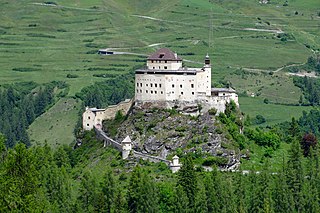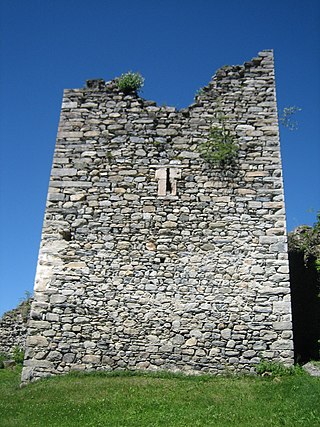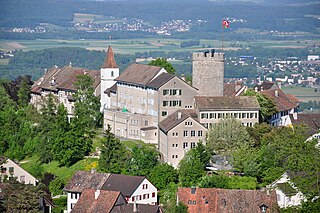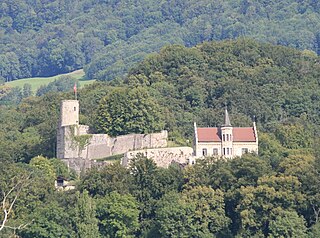
Winterthur is a city in the canton of Zurich in northern Switzerland. With over 120,000 residents, it is the country's sixth-largest city by population, as well as its ninth-largest agglomeration with about 140,000 inhabitants. Located about 20 kilometres (12 mi) northeast of Zurich, Winterthur is a service and high-tech industrial satellite city within Zurich Metropolitan Area.

Tarasp Castle is a castle in Switzerland, near the former municipality of Tarasp, in Lower Engadin, Graubünden. It is a Swiss heritage site of national significance.

The County of Kyburg probably came into existence in the 11th century and is first mentioned in 1027. After 1053 it was a possession of the counts of Dillingen. It was greatly expanded with the extinction of the House of Lenzburg in 1173.
The Kyburg family was a noble family of grafen (counts) in the Duchy of Swabia, a cadet line of the counts of Dillingen, who in the late 12th and early 13th centuries ruled the County of Kyburg, corresponding to much of what is now Northeastern Switzerland.

Falkenstein Castle, also formerly called New Falkenstein Castle to distinguish it from Old Falkenstein Castle, is a German hill castle in the Harz Mittelgebirge, dating to the High Middle Ages. It is located in the town of Falkenstein between Aschersleben and Harzgerode.

Münzenberg Castle is a ruined hill castle in the town of the same name in the Wetteraukreis, Hesse, Germany. It dates from the 12th century. It is one of the best preserved castles from the High Middle Ages in Germany.

Castels Castle is a castle in the municipality of Luzein of the Canton of Graubünden in Switzerland. It is a Swiss heritage site of national significance.

Brandis Castle or Maienfeld Castle is a castle in the municipality of Maienfeld of the Canton of Graubünden in Switzerland. It is a Swiss heritage site of national significance.

Campell or Campi Castle is a castle in the municipality of Sils im Domleschg of the Canton of Graubünden in Switzerland. It is a Swiss heritage site of national significance.

Scherenburg Castle is a ruined hill castle at an elevation of 200 m above sea level (NN) which stands on a hillside above the town of Gemünden am Main in the province of Lower Franconia in the German state of Bavaria.

The ruins of Alt-Trauchburg Castle, also called the Alttrauchburg or Trauchburg, lie above the Weitnau hamlet of Kleinweiler in the county of Oberallgäu in Swabia. Large parts of the original stone walls of the high- to post-medieval castle remain. The ruins are some of the best preserved in the Allgäu region of Germany.

Freistadt Castle in Upper Austrian Mühlviertel was built, together with its bergfried, between 1363 and 1398, and was used to reinforce the fortifications of the town of Freistadt. Today the castle houses the tax office and the Mühlviertel Castle Museum.

The ruins of Sayn Castle, the 12th century family castle of the counts of Sayn and Sayn-Wittgenstein, are in Sayn, part of the borough of Bendorf on the Rhine, between Koblenz and Neuwied in the county of Mayen-Koblenz in the German state of Rhineland-Palatinate.

Hohenfreyberg Castle, together with Eisenberg Castle directly opposite, forms a castle group in the southern Allgäu that is visible from a long way off. It is located about four kilometres north of Pfronten in the county of Ostallgäu. The late mediaeval hilltop castle was abandoned during the Thirty Years' War and set on fire. From 1995 to 2006 the former aristocratic seat was comprehensively made safe and conserved as part of a closely observed "example of renovation".

Regensberg Castle is a hill castle which was built about the mid-13th century AD by the House of Regensberg in the Swiss municipality of Regensberg in the Canton of Zürich.

Bipp Castle is a partially ruined castle in the municipality of Oberbipp of the Canton of Bern in Switzerland.

Trostburg Castle is a small castle in the municipality of Teufenthal in the canton of Aargau in Switzerland.

The Counts of Dillingen were a Swabian comital family of the Hupaldinger (Hucpaldinger) dynasty during AD 955–1286.

The Counts of Winterthur were a Swabian noble family, a branch of the Udalrichinger dynasty, who ruled parts of Thurgau in the 10th and 11th centuries. They are named for the Alemannic settlement at Vitudurum, but their rule predates the foundation of the city of Winterthur in 1180.

Rhäzüns Castle is a castle near Rhäzüns, Graubünden, Switzerland.




























